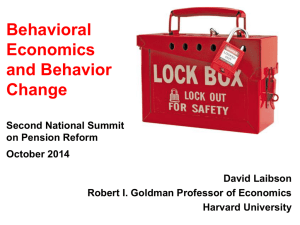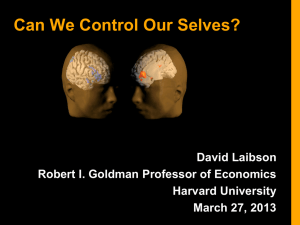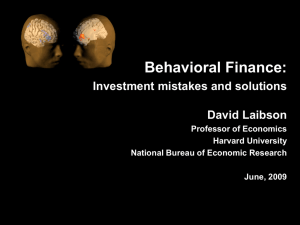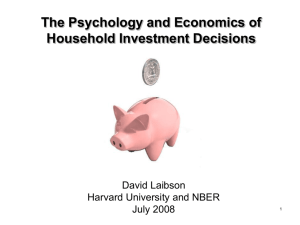PPT - Harvard University
advertisement
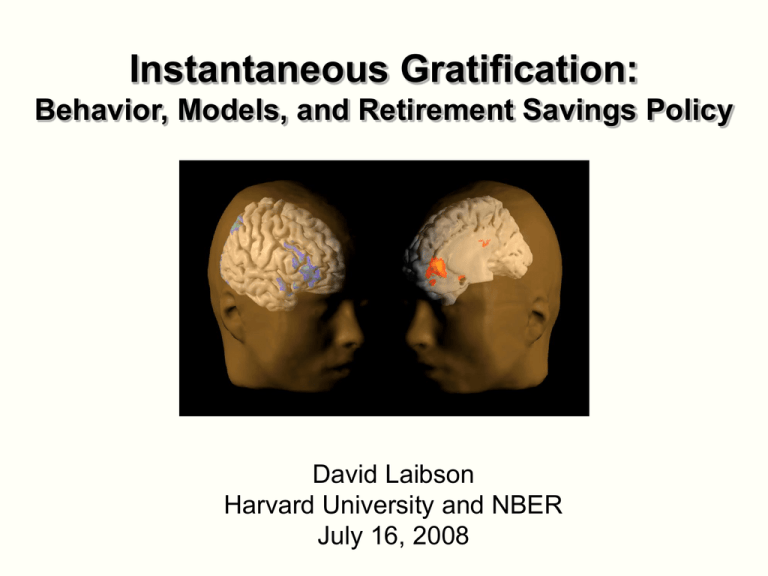
Instantaneous Gratification:
Behavior, Models, and Retirement Savings Policy
David Laibson
Harvard University and NBER
July 16, 2008
1. Motivating Experiments
A Thought Experiment
Would you like to have
A) 15 minute massage now
or
B) 20 minute massage in an hour
Would you like to have
C) 15 minute massage in a week
or
D) 20 minute massage in a week and an hour
Read and van Leeuwen (1998)
Choosing Today
Eating Next Week
Time
If you were
deciding today,
would you choose
fruit or chocolate
for next week?
Patient choices for the future:
Choosing Today
Eating Next Week
Time
Today, subjects
typically choose
fruit for next week.
74%
choose
fruit
Impatient choices for today:
Choosing and Eating
Simultaneously
Time
If you were
deciding today,
would you choose
fruit or chocolate
for today?
Time Inconsistent Preferences:
Choosing and Eating
Simultaneously
Time
70%
choose
chocolate
Read, Loewenstein & Kalyanaraman (1999)
Choose among 24 movie videos
• Some are “low brow”: Four Weddings and a Funeral
• Some are “high brow”: Schindler’s List
• Picking for tonight: 66% of subjects choose low brow.
• Picking for next Wednesday: 37% choose low brow.
• Picking for second Wednesday: 29% choose low brow.
Tonight I want to have fun…
next week I want things that are good for me.
Extremely thirsty subjects
McClure, Ericson, Laibson, Loewenstein and Cohen (2007)
• Choosing between,
juice now
or 2x juice in 5 minutes
60% of subjects choose first option.
• Choosing between
juice in 20 minutes or 2x juice in 25 minutes
30% of subjects choose first option.
• We estimate that the 5-minute discount rate is 50% and
the “long-run” discount rate is 0%.
• Ramsey (1930s), Strotz (1950s), & Herrnstein (1960s)
were the first to understand that discount rates are higher
in the short run than in the long run.
Conceptual Outline
• People are not internally consistent decision-makers
• Internal conflicts can be modeled and measured
• Scalable, inexpensive policies can transform behavior
Outline
1.
2.
3.
4.
5.
Motivating experimental evidence
Theoretical framework
Field evidence
Neuroscience foundations
Neuroimaging evidence
– Study 1: Amazon gift certificates
– Study 2: chips and juice
6. Policy analysis
2. Theoretical Framework
• Classical functional form: exponential functions.
D(t) = dt
D(t) = 1, d, d2, d3, ...
Ut = ut + d ut+1 + d2 ut+2 + d3 ut+3 + ...
• But exponential function does not show instant
gratification effect.
• Discount function declines at a constant rate.
• Discount function does not decline more quickly in
the short-run than in the long-run.
Discounted value of
delayed reward
Exponential Discount Function
1
Constant rate of decline
0
1
11
21
31
41
Week (time = t)
-D'(t)/D(t) = rate of decline of a discount function
Exponential
Hyperbolic
51
Discount Functions
Slow rate of decline
in long run
1
Rapid rate
of decline
in short run
0
1
11
21
31
41
Week
Exponential
Hyperbolic
51
An exponential discounting paradox.
Suppose people discount at least 1% between today and
tomorrow.
Suppose their discount functions were exponential.
Then 100 utils in t years are worth 100*e(-0.01)*365*t utils today.
•
•
•
•
What is 100 today worth today?
What is 100 in a year worth today?
What is 100 in two years worth today?
What is 100 in three years worth today?
100.00
2.55
0.07
0.00
An Alternative Functional Form
Quasi-hyperbolic discounting
(Phelps and Pollak 1968, Laibson 1997)
D(t) = 1, bd, bd2, bd3, ...
Ut = ut + bdut+1 + bd2ut+2 + bd3ut+3 + ...
Ut = ut + b [dut+1 + d2ut+2 + d3ut+3 + ...]
b uniformly discounts all future periods.
d exponentially discounts all future periods.
Building intuition
• To build intuition, assume that b = ½ and d = 1.
• Discounted utility function becomes
Ut = ut + ½ [ut+1 + ut+2 + ut+3 + ...]
• Discounted utility from the perspective of time t+1.
Ut+1 =
ut+1 + ½ [ut+2 + ut+3 + ...]
• Discount function reflects dynamic inconsistency:
preferences held at date t do not agree with preferences
held at date t+1.
Exercise
• Assume that b = ½ and d = 1.
• Suppose exercise (current effort 6) generates delayed
benefits (health improvement 8).
• Will you exercise?
• Exercise Today:
• Exercise Tomorrow:
-6 + ½ [8] = -2
0 + ½ [-6 + 8] = +1
• Agent would like to relax today and exercise tomorrow.
• Agent won’t follow through without commitment.
3. Field Evidence
Della Vigna and Malmendier (2004)
•
•
•
•
Average cost of gym membership: $75 per month
Average number of visits: 4
Average cost per vist: $19
Cost of “pay per visit”: $10
Choi, Laibson, Madrian, Metrick (2002)
(unreliable?) self-reports about undersaving.
• Survey
–Mailed to 590 employees (random sample)
–195 usable responses
–Matched to administrative data on actual savings behavior
• Consider a population of 100 respondents
–68 report saving too little
–24 of 68 plan to raise 401(k) contribution in next 2 months
–Only 3 of 24 actually do so in the next 4 months
Financial education
Choi, Laibson, Madrian, Metrick (2004)
• Seminars presented by professional financial
advisors
• Curriculum: Setting savings goals, asset allocation,
managing credit and debt, insurance against
financial risks
• Seminars offered throughout 2000
• Linked data on individual employees’ seminar
attendance to administrative data on actual savings
behavior before and after seminar
Effect of education is positive but small
Seminar attendees
Non-attendees
%
planning
to make
change
%
actually
made
change
%
actually
made
change
100%
14%
7%
Increase contribution rate
28%
8%
5%
Change fund selection
47%
15%
10%
Change asset allocation
36%
10%
6%
Those not in 401(k)
Enroll in 401(k) Plan
Those already in 401(k)
$100 bills on the sidewalk
Choi, Laibson, Madrian (2004)
• Employer match is an instantaneous, riskless return on
investment
• Particularly appealing if you are over 59½ years old
– Have the most experience, so should be savvy
– Retirement is close, so should be thinking about saving
– Can withdraw money from 401(k) without penalty
• We study seven companies and find that on average, half of
employees over 59½ years old are not fully exploiting their
employer match
– Average loss is 1.6% of salary per year
• Educational intervention has no effect
Laibson, Repetto, and Tobacman (2007)
Use MSM to estimate discounting parameters:
– Substantial illiquid retirement wealth: W/Y = 3.9.
– Extensive credit card borrowing:
• 68% didn’t pay their credit card in full last month
• Average credit card interest rate is 14%
• Credit card debt averages 13% of annual income
– Consumption-income comovement:
• Marginal Propensity to Consume = 0.23
(i.e. consumption tracks income)
LRT Simulation Model
•
•
•
•
•
•
•
•
Stochastic Income
Lifecycle variation in labor supply (e.g. retirement)
Social Security system
Life-cycle variation in household dependents
Bequests
Illiquid asset
Liquid asset
Credit card debt
• Numerical solution (backwards induction) of 90
period lifecycle problem.
LRT Results:
Ut = ut + b [dut+1 + d2ut+2 + d3ut+3 + ...]
•
•
•
•
b = 0.70 (s.e. 0.11)
d = 0.96 (s.e. 0.01)
Null hypothesis of b = 1 rejected (t-stat of 3).
Specification test accepted.
Simulated (Hyperbolic)
Moments: Empirical
%Visa:
68%
63%
Visa/Y:
13%
17%
MPC:
23%
31%
f(W/Y):
2.6
2.7
4. Neuroscience Foundations
•
•
•
•
•
What is the underlying mechanism?
Why are our preferences inconsistent?
Is it adaptive?
How should it be modeled?
Does it arise from a single time preference
mechanism (e.g., Herrnstein’s reward per unit time)?
• Or is it the resulting of multiple systems interacting
(Shefrin and Thaler 1981, Bernheim and Rangel
2004, O’Donoghue and Loewenstein 2004,
Fudenberg and Levine 2004)?
Shiv and Fedorikhin (1999)
• Cognitive burden/load is manipulated by having
subjects keep a 2-digit or 7-digit number in mind as
they walk from one room to another
• On the way, subjects are given a choice between a
piece of cake or a fruit-salad
Processing burden
% choosing cake
Low (remember only 2 digits)
41%
High (remember 7 digits)
63%
Meso-limbic dopamine system
vs. Fronto-Parietal System
Frontal
cortex
Mesolimbic dopamine system
Parietal
cortex
Relationship to quasi-hyperbolic model
• Hypothesize that mesolimbic dopamine system is
impatient.
• Hypothesize that the fronto-parietal system is patient
• Here’s one implementation of this idea:
Ut =
ut + b [dut+1 + d2ut+2 + d3ut+3 + ...]
(1/b)Ut =
(1/b)ut + dut+1 + d2ut+2 + d3ut+3 + ...
(1/b)Ut =(1/b-1)ut + [d0ut + d1ut+1 + d2ut+2 + d3ut+3 + ...]
limbic
fronto-parietal cortex
Hypothesis:
Limbic system discounts reward at a higher rate than does the
prefrontal cortex.
1.0
discount value
mesolimbic system
prefrontal cortex
0.0
time
5. Neuroimaging Evidence
McClure, Laibson, Loewenstein, and Cohen
Science (2004)
• Do agents think differently about immediate rewards and
delayed rewards?
• Does immediacy have a special emotional drive/reward
component?
• Does emotional (mesolimbic) brain discount delayed
rewards more rapidly than the analytic (fronto-parietal
cortex) brain?
Choices involving Amazon gift certificates:
Time
delay
Reward
d>0
d’
R
R’
Hypothesis: fronto-parietal cortex.
Time
delay
d=0
d’
Reward R
R’
Hypothesis: fronto-parietal cortex and limbic.
McClure, Laibson, Loewenstein, and Cohen
Science (2004)
Emotional system responds only to immediate rewards
7
T13
0
Neural activity
x = -4mm
VStr
y = 8mm
MOFC
z = -4mm
MPFC
PCC
Seconds
d = Earliest reward available today
d = Earliest reward available in 2 weeks
d = Earliest reward available in 1 month
0.4%
2s
Analytic brain responds equally to all rewards
VCtx
PMA
RPar
DLPFC
VLPFC
LOFC
x = 44mm
0.4%
2s
x = 0mm
0
T13
15
d = Earliest reward available today
d = Earliest reward available in 2 weeks
d = Earliest reward available in 1 month
Brain Activity
Brain Activity in the Frontal System and
Emotional System Predict Behavior
(Data for choices with an immediate option.)
0.05
0.0
-0.05
Choose
Smaller
Immediate
Reward
Frontal
system
Emotional
System
Choose
Larger
Delayed
Reward
Conclusions of Amazon study
• Time discounting results from the combined influence of
two neural systems:
• Mesolimbic dopamine system is impatient.
• Fronto-parietal system is patient.
• These two systems are separately implicated in
‘emotional’ and ‘analytic’ brain processes.
• When subjects select delayed rewards over
immediately available alternatives, analytic cortical areas
show enhanced changes in activity.
Open questions
1. What is now and what is later?
• Our “immediate” option (Amazon gift certificate)
did not generate immediate “consumption.”
• Also, we did not control the time of consumption.
2. How does the limbic signal decay as rewards are delayed?
3. Would our results replicate with a different reward domain?
4. Would our results replicate over a different time horizon?
New experiment on primary rewards: Juice
McClure, Ericson, Laibson, Loewenstein, Cohen
(Journal of Neuroscience, 2007)
Subjects water deprived for 3hr prior to experiment
(subject scheduled for 6:00)
A
15s
i
ii
10s
5s
Time
…
iii
iv. Juice/Water squirt (1s
)
B
(i) Decision Period
Free (10s max.)
(ii) Choice Made
2s
15s
Figure 1
(iii) Pause
Variable Duration
(iv) Reward Delivery
Free (1.5s Max)
Experiment Design
d
d'-d
(R,R')
{ This minute, 10 minutes, 20 minutes }
{ 1 minute, 5 minutes }
{(1,2), (1,3), (2,3)}
d = This minute
d'-d = 5 minutes
(R,R') = (2,3)
P(choose early)
Behavioral evidence for
non-exponential discounting
0.8
0.6
0.4
0.2
0
This
minute
10
minutes
20
Minutes
Delay to early reward (d)
P(choose early)
Behavioral evidence for
non-exponential discounting
0.8
0.8
0.6
0.6
0.4
0.4
0.2
0.2
0
0
This
minute
10
minutes
20
Minutes
Delay to early reward (d)
d’-d = 1 min
d’-d = 5 min
This
minute
10
minutes
20
minutes
Delay to early reward (d)
Discount functions fit to behavioral data
β = 0.53 (se = 0.041)
δ = 0.98 (se = 0.014)
Limbic
Cortical
b= 0.47 (se = 0.101)
d = 1.02 (se = 0.018)
• Evidence for two-system model
• Can reject restriction to a single exponential: t-stat > 5
• Double exponential generalization fits data best
Neuroimaging data
Areas that respond primarily to immediate rewards
ACC
PCu
NAcc
x = -12mm
SGC
x = -2mm
PCu
NAcc
ACC
PCC
MOFC/SGC
z = -10mm
x = -8mm
Areas that show little discounting
PCC
BA10
SMA/PMA
BA9/44
BA46
11
PPar
Vis Ctx
x = 0mm
Ant Ins
x = 40mm
x = -48mm
T
0
Figure 4
Comparison with Amazon experiment:
Impatient areas (p<0.001)
x = 0mm
y = 8mm
Patient areas (p<0.001)
x = 0mm
x = -48mm
Juice
only
Figure 5
Impatient areas (p<0.01)
x = -4mm
y = 12mm
Patient areas (p<0.01)
x = 0mm
Amazon
only
x = -48mm
Both
Measuring discount functions
using neuroimaging data
• Impatient voxels are in the emotional
(mesolimbic) reward system
• Patient voxels are in the analytic
(prefrontal and parietal) cortex
• Average (exponential) discount rate in
the impatient regions is 4% per minute.
• Average (exponential) discount rate in
the patient regions is 1% per minute.
1.5
2
Average Beta Area Activation, Actual and Predicted
(D=0,D'=1)
1
(D=0,D'=5)
(D=10,D'=11)
(D=10,D'=15)
(D=20,D'=25)
0
.5
(D=20,D'=21)
0
5
10
15
Time to later reward
Actual
Predicted
20
25
1
1.5
2
Average Delta Area Activation, Actual and Predicted
(D=0,D'=1)
(D=10,D'=15)
(D=0,D'=5)
(D=10,D'=11)
(D=20,D'=25)
0
.5
(D=20,D'=21)
0
5
10
15
Time to later reward
Actual
Predicted
20
25
Summary of neuroimaging evidence
• One system associated with midbrain dopamine
neurons (mesolimbic dopamine system) discounts at
a high rate.
• Second system associated with lateral prefrontal and
posterior parietal cortex discounts at a low rate.
• Combined function of these two systems accounts for
decision making consistently across choice domains,
including non-exponential discounting regularities.
Outline
1.
2.
3.
4.
Experimental evidence for dynamic inconsistency.
Theoretical framework: quasi-hyperbolic discounting.
Field evidence: dynamic decisions.
Neuroscience:
– Mesolimbic Dopamine System (emotional, impatient)
– Fronto-Parietal Cortex (analytic, patient)
5. Neuroimaging evidence
– Study 1: Amazon gift certificates
– Study 2: juice squirts
6. Policy
7. The Age of Reason
6. Policy
Defaults in the savings domain
• Welcome to the company
• If you don’t do anything
– You are automatically enrolled in the 401(k)
– You save 2% of your pay
– Your contributions go into a default fund
• Call this phone number to opt out of enrollment
or change your investment allocations
Madrian and Shea (2001)
Choi, Laibson, Madrian, Metrick (2004)
401(k) participation by tenure at firm
100%
Automatic
enrollment
80%
60%
Standard
enrollment
40%
20%
0%
0
6
12
18
24
30
36
Tenure at company (months)
42
48
Employees enrolled under automatic
enrollment cluster at default contribution rate.
Fraction of Participants at different contribution rates:
67%
Default contribution
rate under automatic
enrollment
37%
20%
7%
3% 1%
1%
17%
2%
3%–5%
14%
14%
6%
6%
7%–10%
Contribution Rate
Before Auto Enrollment
After Auto Enrollment
9%
4%
11%–16%
Participants stay at the automatic enrollment
defaults for a long time.
Fraction of participants hired during automatic enrollment
Fraction of Participants Hired Under Automatic Enrollment
at both default contribution rate and asset allocation
who are still at both Default Contribution Rate and Asset Allocation
Participants
of participants
Fraction of
Fraction
100%
Company B
Company C
Company D
80%
60%
40%
20%
0%
0
6
12
18
24
30
36
42
48
Tenure at
(Months)
Tenure
at Company
company (months)
Company B
Company C
Company D
Do people like a little paternalism?
Survey given to workers who were subject to automatic
enrollment:
“You are glad your company offers automatic
enrollment.”
Agree? Disagree?
• Enrolled employees:
• Non-enrolled employees:
• All employees:
98% agree
79% agree
97% agree
Source: Harris Interactive Inc.
The power of deadlines: Active decisions
Carroll, Choi, Laibson, Madrian, Metrick (2004)
Active decision mechanisms require employees to
make an active choice about 401(k) participation.
• Welcome to the company
• You are required to submit this form within 30 days of
hire, regardless of your 401(k) participation choice
• If you don’t want to participate, indicate that decision
• If you want to participate, indicate your contribution
rate and asset allocation
• Being passive is not an option
401(k) participation by tenure
Fraction of employees ever
participated
100%
Active Decision Cohort
80%
Standard enrollment cohort
60%
40%
20%
0%
0
6
12 18 24 30 36 42
Tenure at company (months)
Active decision cohort
48
Standard enrollment cohort
54
Simplified enrollment raises participation
Fraction Ever Participating in Plan
Beshears, Choi, Laibson, Madrian (2006)
50%
2005
2004
40%
30%
2003
20%
10%
0%
0
3
6
9
12 15 18 21 24 27 30 33
Time since baseline (months)
Outline
1.
2.
3.
4.
5.
6.
Motivating experimental evidence
Theoretical framework
Field evidence
Neuroscience foundations
Neuroimaging evidence
Policy discussion
• Defaults
• Deadlines
• Simplicity (make it easy)
A copy of these slides will soon be available on my
Harvard website.
End
Should Defaults Influence Economic
Outcomes?
• Standard neoclassical theory:
If transactions costs are small and
stakes are large, defaults should not influence
rational consumers.
• In practice, defaults make an enormous
difference:
– Organ donation
– Car insurance
– Car purchase options
– Consent to receive e-mail marketing
– Savings
– Asset allocation
Overview of defaults
1. Defaults affect all saving and asset
allocation outcomes
2. Four psychological factors jointly
contribute to the default effect
3. How can we identify optimal defaults
4. Alternative interventions (education)
is much less effective
1. Defaults Affect Saving and
Asset Allocation
i.
ii.
iii.
iv.
v.
Participation
Contribution rates
Asset allocation
Pre-retirement distributions
Decumulation / annuitization
Participation, Contribution rates, and
Asset Allocation
Automatic Enrollment in a US 401(k) plan
• Welcome to the company
• If you don’t do anything…
– You are automatically enrolled in the 401(k)
– You save 2% of your pay
– Your contributions go into a money market
fund
• Call this phone number to opt out of enrollment
or change your investment allocations
Madrian and Shea (2001)
Choi, Laibson, Madrian, Metrick (2004)
Fraction of employees
ever participated
401(k) participation by tenure at firm
100%
80%
60%
40%
20%
0%
0
6
12
18
24
30
36
42
Tenure at company (months)
Hired before automatic enrollment
Hired after automatic enrollment ended
48
Hired during automatic enrollment
Employees enrolled under auto-enrollment
cluster at the default contribution rate.
Fraction of participants
Distribution of contribution rates
80%
70%
60%
50%
40%
30%
20%
10%
0%
Default contribution
rate under automatic
enrollment
67
37
31
26
20
9
6
3
18
17
14
7
14
6
1
1%
2%
Hired before automatic enrollment
Hired after automatic enrollment ended
3-5%
6%
Contribution rate
7-10%
10
9
4
11-16%
Hired during automatic enrollment (2% default)
Participants stay at the automatic enrollment
defaults for a long time.
Fraction of participants
Fraction of participants hired during auto-enrollment
at both default contribution rate and asset allocation
100%
80%
60%
40%
20%
0%
0
6
12
18
24
30
36
Tenure at company (months)
Company B
Company C
42
Company D
48
Four psychological factors
contribute to the default effect
i.
ii.
iii.
iv.
Financial illiteracy
Endorsement
Complexity
Present-bias
iii. Complexity
Complexity delay
• Psychology literature (Tversky and Shafir
1992, Shafir, Simonson and Tversky 1993,
Dhar and Knowlis 1999, Iyengar and Lepper
2000 )
• Savings literature: each additional 10 funds
produces a 1.5 to 2.0 percentage point
decline in participation (Iyengar, Huberman
and Jiang 2004)
• Also results on complexity generating more
conservative asset allocation (Iyengar and
Kamenica 2007).
• Quick enrollment experiments
Complexity and Quick Enrollment
• Conceptual Idea
– Simplify the savings plan enrollment decision by
giving employees an easy way to elect a preselected contribution rate and asset allocation
bundle
• Implementation at Company D
– New hires at employee orientation: 2%
contribution rate invested 50% money market /
50% stable value
• Implementation at Company E
– Existing non-participants: 3% contribution rate
invested 100% in money market fund
iv. Present-Biased Preferences
• Self control and savings outcomes: Why do
today what you can put off until tomorrow?
(Laibson 1997; O’Donoghue and Rabin 1999;
Diamond and Koszegi 2003)
• Framework: exponential discounting with an
additional factor, β<1, that uniformly downweights the future.
Ut =
ut + b [dut+1 + d2ut+2 + d3ut+3 + ...]
Procrastination (assume b = ½ ,
d = 1).
• Suppose you can join the plan today (effort cost
$50) to gain delayed benefits $20,000 (e.g. value of
match)
• Every period you delay, total benefits fall by $10.
• What are the discounted costs of joining at different
periods?
•
•
•
•
Join Today:
Join t+1:
Join t+2:
Join t+3:
-50
0
+
+
0 +
0 +
½ [0]
½ [-50 - 10]
½ [-50 - 20]
½ [-50 - 30]
= -50
= -30
= -35
= -40
Interaction with financial
illiteracy
• Consider someone with a high level of financial literacy,
so effort cost is only $10 (not $50)
• As before, every period of delay, total benefits fall by
$10.
• What are the discounted costs of joining at different
periods?
•
•
•
•
Join Today:
Join t+1:
Join t+2:
Join t+3:
-10
0
0
0
+
+
+
+
½ [0]
½ [-10 - 10]
½ [-10 - 20]
½ [-10 - 30]
= -10
= -10
= -15
= -20
Interaction with endorsement
and complexity
• Consider a plan with a simple form, or an endorsed
form, so the effort cost is again only $10 (not $50)
• As before, every period of delay, total benefits fall by
$10.
• What are the discounted costs of joining at different
periods?
•
•
•
•
Join Today:
Join t+1:
Join t+2:
Join t+3:
-10
0
0
0
+
+
+
+
½ [0]
½ [-10 - 10]
½ [-10 - 20]
½ [-10 - 30]
= -10
= -10
= -15
= -20
3. Optimal Defaults – public
policy
• Mechanism design problem in which
policy makers set a default for agents
with present bias (Carrol, Choi, Laibson,
Madrian and Metrick 2007)
• Defaults are sticky for three reasons
– Cost of opting-out of the default
– Cost varies over time option value of
waiting
– Present-biased preferences
Basic set-up of problem
• Specify behavioral model of households
– Flow cost of staying at the default
– Effort cost of opting-out of the default
– Effort cost varies over time option value of
waiting to leave the default
– Present-biased preferences procrastination
• Specify (dynamically consistent) social
welfare function of planner (e.g., set β=1)
• Planner picks default to optimize social
welfare function
Optimal ‘Defaults’
• Two classes of optimal defaults
– Automatic enrollment
• Optimal when employees have relatively homogeneous
savings preferences (e.g. match threshold) and
relatively little propensity to procrastinate
– “Active Decision” — require individuals to make a
decision (eliminate the option to passively accept a
default)
• Optimal when employees have relatively
heterogeneous savings preferences and relatively
strong tendency to procrastinate
• Key point: sometimes the best default is no
default.
High Heterogeneity
30%
Offset
Default
Low Heterogeneity
Active Decision
Center
Default
0%
0
Beta
1
Lessons from theoretical
analysis of defaults
– Defaults should be set to maximize
average well-being, which is not the same
as saying that the default should be equal
to the average preference.
– Endogenous opting out should be taken
into account when calculating the optimal
default.
– The default has two roles:
• causing some people to opt out of the default
(which generates costs and benefits)
• implicitly setting savings policies for everyone
who sticks with the default
The power of deadlines: Active
decisions
Choi, Laibson, Madrian, Metrick (2007)
Active decision mechanisms require employees to
make an active choice about 401(k) participation.
• Welcome to the company
• You are required to submit this form within 30
days of hire, regardless of your 401(k)
participation choice
• If you don’t want to participate, indicate that
decision
• If you want to participate, indicate your
contribution rate and asset allocation
• Being passive is not an option
401(k) participation by tenure
Fraction of employees ever
participated
100%
80%
60%
40%
20%
0%
0
6
12 18 24 30 36 42
Tenure at company (months)
Active decision cohort
48
Standard enrollment cohort
54
Active decisions: conclusions
• Active decision raises 401(k) participation.
• Active decision raises average savings rate by 50
percent.
• Active decision doesn’t induce choice clustering.
• Under active decision, employees choose savings
rates that they otherwise would have taken three years
to achieve. (Average level as well as the entire
multivariate covariance structure.)
New directions for defaults
•
•
•
•
•
•
•
•
Defaults for savings rate escalation
Defaults with high savings rates
Defaults for lifecycle rebalancing
Defaults for annual rebalancing
Defaults for employer stock
Defaults at separation
Defaults for annuitization
Individualized defaults (savings rate and asset
allocation)
• Defaults for employees not covered by DB/DC plans
• Defaults for investment of tax refunds
4. Alternative Policies
• Paying employees to save
• Educating employees
$100 bills on the sidewalk
Choi, Laibson, Madrian (2004)
• Employer match is an instantaneous, riskless return on
investment
• Particularly appealing if you are over 59½ years old
– Have the most experience, so should be savvy
– Retirement is close, so should be thinking about
saving
– Can withdraw money from 401(k) without penalty
• We study seven companies and find that on average,
half of employees over 59½ years old are not fully
exploiting their employer match
– Average loss is 1.6% of salary per year
• Educational intervention has no effect
Financial education
Choi, Laibson, Madrian, Metrick
(2004)
• Seminars presented by professional financial
advisors
• Curriculum: Setting savings goals, asset allocation,
managing credit and debt, insurance against
financial risks
• Seminars offered throughout 2000
• Linked data on individual employees’ seminar
attendance to administrative data on actual savings
behavior before and after seminar
Effect of education is positive but
Seminar attendees
Nonsmall
attendees
%
planning
to make
change
%
actually
made
change
%
actually
made
change
100%
14%
7%
28%
8%
5%
Change fund selection
47%
15%
10%
Change asset
36%
10%
6%
Those not in 401(k)
Enroll in 401(k) Plan
Those already in 401(k)
Increase contribution
rate
Effect of education is positive but
Seminar attendees
Nonsmall
attendees
%
planning
to make
change
%
actually
made
change
%
actually
made
change
100%
14%
7%
28%
8%
5%
Change fund selection
47%
15%
10%
Change asset
36%
10%
6%
Those not in 401(k)
Enroll in 401(k) Plan
Those already in 401(k)
Increase contribution
rate
Effect of education is positive but
Seminar attendees
Nonsmall
attendees
%
planning
to make
change
%
actually
made
change
%
actually
made
change
100%
14%
7%
28%
8%
5%
Change fund selection
47%
15%
10%
Change asset
36%
10%
6%
Those not in 401(k)
Enroll in 401(k) Plan
Those already in 401(k)
Increase contribution
rate
• Financial education effects are small
• Seminar attendees have good intentions to change
their 401(k) savings behavior, but most do not
follow through
• Financial education alone will not dramatically
improve the quality of 401(k) savings outcomes
• Choi et al (2005) study the effect of the Enron,
Worldcom, and Global Crossing scandals on
employer stock holding
• No net sales of employer stock in reaction to these news
stories
• These scandals did not affect the asset allocation decisions
of new hires.
• These hires did not affect the asset allocation decisions of
new hires at other Houston firms.
Conclusion
• Defaults are not neutral for four reasons:
–
–
–
–
Investors are not financially literate
Investors display an endorsement effect
Investors respond adversely to complexity
Investors are prone to procrastinate
• Employers/institutions will influence savings
outcomes through the choice of defaults
(whether the institution wants to do this or not)
• We should devote more effort to the analysis of
how we pick defaults.
